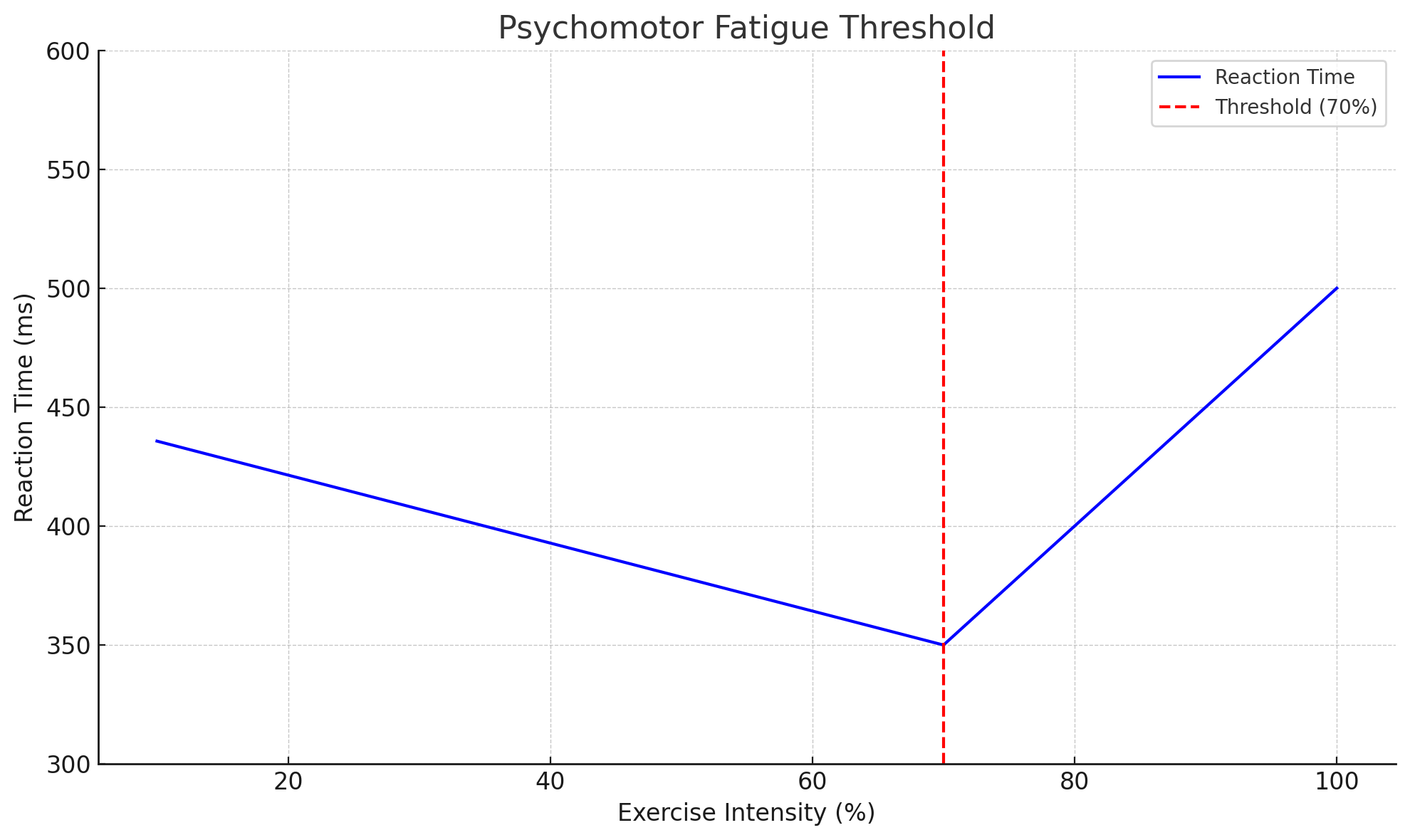Psychomotor Fatigue Threshold: Finding The Limit
The Psychomotor Fatigue Threshold Test identifies the sweet spot where an athlete's decisions are at their quickest and most accurate, unhindered by fatigue or overload.

In sports, peak performance isn't just about how fast you run or how high you jump. It's about the intricate dance between physical exertion and cognitive sharpness. At the heart of this dance is the Psychomotor Fatigue Threshold (PFTT), a tool that assesses the exact point where an athlete's cognitive responses, specifically reaction times, are at their prime during increasing exercise intensities.
How It Works
As physical intensity rises during exercise, cognitive performance initially follows suit, sharpening until a pinnacle point. Beyond this, even if the body continues to soldier on, the brain starts to show signs of fatigue. This pivotal juncture is what the Psychomotor Fatigue Threshold Test identifies. In simpler terms, it's the sweet spot—where an athlete's decisions are quickest and most accurate, unhindered by fatigue or overload.

Why It's Game-Changing
Complete Performance Picture: This test doesn't just measure how long or hard an athlete can push. It looks at how efficiently their brain works under load, providing a comprehensive view of an athlete's capabilities.
Training Precision: By identifying this threshold, coaches can tailor training sessions with surgical precision. Instead of generalized regimes, training can be meticulously crafted to extend this threshold, pushing both physical and cognitive boundaries.
Real-World Benefits: Sports often demand split-second decisions in high-pressure scenarios. Understanding where an athlete's cognitive sharpness peaks can be invaluable, especially in games where a fraction of a second can be the difference between victory and defeat.
Decoding the Interplay: OBLA and PFTT
The Essence of OBLA
Every athlete is familiar with the burn that comes from pushing their body to its limits. This is where the Onset of Blood Lactate Accumulation (OBLA) comes into play. OBLA signifies the tipping point during high-intensity exercise when lactate, produced in muscles, accumulates faster than the body can clear it. Beyond this threshold, despite the athlete's willpower, physical performance may begin to decline.
The Cognitive Counterpart: Psychomotor Fatigue Threshold Test
However, while the body might be nearing its physical limits, what's happening in the brain? The Psychomotor Fatigue Threshold Test (PFTT) serves as a mirror, reflecting cognitive performance during these physically demanding moments. As exercise intensity ratchets up, Psychomotor Fatigue Threshold (PFT) initially sharpens, showcasing improved cognitive function. Yet, there's a saturation point, a ceiling, after which cognitive abilities begin their descent.
The Crucial Connection
A groundbreaking study involving elite male soccer players explored the relationship between the Onset of Blood Lactate Accumulation (OBLA) and the psychomotor fatigue threshold, defined as the point of optimal Choice Reaction Time (CRT).
Study Breakdown:
Shifting Thresholds: After a 6-week training regimen, two pivotal shifts were observed. Both the OBLA and the psychomotor fatigue threshold advanced to higher running speeds. This signifies that consistent training not only enhanced athletes' physical stamina but also raised the point where their cognitive response was most efficient.
A Tandem Relationship: The research underscored a robust correlation between the running speed at which OBLA manifests and the speed correlating to the shortest CRT. Essentially, as athletes pushed their physical boundaries through training, there was a concurrent and proportional boost in their cognitive performance threshold. This highlights the intricate interplay between physical exertion and cognitive acuity in athletes, suggesting that peak athletic performance is about optimizing both physical and cognitive capacities.
Implications for Training
- Beyond Physicality: These insights underscore the idea that training isn't just about building physical strength and stamina. It's about balancing physical exertion with cognitive sharpness.
- Tailored Training Regimes: With a clear understanding of where an athlete's OBLA and PFT intersect, coaches can design training sessions that challenge both body and mind, ensuring that athletes are optimized for real-world sporting scenarios.
Harnessing Data for Tailored Training Regimens
The Power of Precision
In the digital age, where data analytics drives decisions across industries, sports science is no exception. When it comes to training athletes, precision can be the difference between a good performance and a great one. Leveraging data from the Psychomotor Fatigue Threshold Test provides this precision.
Insights from PFT Data
- Individualized Thresholds: Every athlete is unique. By analyzing PFT data, coaches can identify the specific point at which each athlete's cognitive performance starts to decline. This knowledge allows for a personalized training approach, ensuring that athletes are always operating at their peak cognitive efficiency.
- Monitoring Progress: Regular PFT assessments can chart an athlete's cognitive improvements over time. Are they able to sustain peak cognitive performance for longer durations? Or do they reach their threshold more quickly in certain conditions or situations? Such insights can be pivotal in refining training strategies.
Incorporating Feedback
- In-the-Moment Adjustments: Immediate feedback from PFT tests can allow coaches to make on-the-spot training adjustments, ensuring that athletes are not overtaxing their cognitive faculties.
- Strategizing Recovery: If an athlete consistently hits their psychomotor fatigue threshold early in a training session, it could indicate the need for more rest and recovery. Recognizing this early can prevent potential burnout or injury.
Athlete Development
- Balancing Physical and Cognitive Training: By understanding an athlete's PFT and OBLA, coaches can design training sessions that provide a balanced challenge to both the body and the mind. This approach ensures comprehensive athlete development, preparing them for the myriad challenges they'll face in competition.
Practical Implementation: Integrating the Psychomotor Fatigue Threshold Test
Initial Assessment and Baseline Establishment
Before diving into regular training, it's essential to have a clear starting point:
- Baseline Testing: Conduct the Psychomotor Fatigue Threshold Test under controlled conditions to determine the initial PFT for each athlete. This will serve as the reference point for all future assessments.
- Understanding the Data: Once the baseline is established, sit down with each athlete to explain their results. This educative step ensures they comprehend the significance of the data and its implications for their training.
Incorporating PFTT into Training Sessions
- Segmented Training: Divide training sessions into segments, with periodic PFT tests. This approach helps monitor when and if athletes approach their cognitive thresholds, allowing for timely adjustments.
- Combining Physical and Cognitive Drills: Introduce cognitive tasks that challenge both the body and the brain. For instance, after a high-intensity sprint, athletes could engage in a 3 minute cognitive task during there rest period, simulating the real-world scenario of making decisions under physical strain.
Feedback and Recovery
- Post-Session Analysis: After every training session, review the PFT data with athletes. Discuss any notable shifts in their thresholds and adjust future training plans accordingly.
- Recovery Protocols: If an athlete frequently hits their PFT early in training sessions, consider integrating cognitive recovery protocols. Techniques might include mindfulness, binaural beats, or even strategic breaks during training.
Periodic Re-evaluations
- Monthly or Quarterly Tests: Regularly reassess each athlete's PFT to track progress and ensure training regimens remain effective and relevant.
- Adjusting to New Thresholds: As athletes improve, their PFT will likely shift, indicating enhanced cognitive resilience. Training plans should evolve in response to these new thresholds.
The Psychomotor Fatigue Threshold in Action: Real-World Impact
Case Study 1: The Marathon Runner
Background: James, a seasoned marathon runner, often found himself struggling in the last few miles of a race. Despite being physically conditioned, he felt mentally exhausted, making poor decisions like misjudging his pace or taking water breaks at the wrong times.
Application of PFT: Through the Psychomotor Fatigue Threshold Test, it was discovered that James' cognitive functions began declining after 20 miles, even though his physical stamina remained strong.
Adjustment: His training was revamped to include cognitive drills post the 20-mile mark, simulating the conditions of the marathon's final stretch.
Result: Over time, James' PFT improved, allowing him to maintain optimal decision-making even in the marathon's final miles. This change played a pivotal role in shaving minutes off his personal best.
Case Study 2: The Football Team
Background: A top-tier soccer team found that they were conceding goals in the final minutes of matches. While their physical fitness was impeccable, lapses in concentration and decision-making were evident.
Application of PFT: The entire team underwent the Psychomotor Fatigue Threshold Test. It revealed a common trend: most players' cognitive functions dipped significantly after 80 minutes of play.
Adjustment: Training sessions were altered to mimic the high-intensity scenarios of a match's final 10 minutes. Players were drilled both physically and then cognitively after there training session when they already physically fatigued and at their limits in order to push them further.
Result: Not only did the team's PFT improve, but their on-field performance in the dying minutes of games also transformed dramatically. They began scoring more goals in the final stages and conceded fewer.
Case Study 3: The Tennis Prodigy
Background: Anna, a 16-year-old tennis prodigy, showcased immense promise but struggled in long, drawn-out matches. Her coaches couldn't pinpoint the issue since her physical endurance was outstanding.
Application of PFT: Anna's PFT test results provided clarity. Her cognitive threshold was being reached midway through the second set, leading to poor shot choices and strategy decisions.
Adjustment: Anna's training was restructured, focusing on maintaining cognitive sharpness during extended play. Cognitive Tasks were placed prior to training, between sets during rest periods and after her physical training sessions to push her to her cognitive limits.
Result: Anna began turning the tide in matches. Her improved PFT meant she stayed sharp, even in tiebreakers and final sets, leading to a string of victories in junior tournaments.
Conclusion: The Limit is Just the Beginning
The Psychomotor Fatigue Threshold Test marks a profound shift from conventional training methodologies. Traditionally, sports training has been primarily centered on physical attributes, emphasizing endurance, strength, and agility. However, with the introduction of the PFTT, the narrative is evolving to equally prioritize cognitive performance. This viewpoint underscores that athletes aren't merely physical entities moving across the field or track; they are brains in real-time action, executing split-second decisions that can pivot the outcome of a match or race.
Research
Changes of Reaction Time and Blood Lactate Concentration of Elite Volleyball Players During a Game
Psychomotor performance during prolonged exercise above and below the blood lactate threshold
Mental Fatigue and Sport-Specific Psychomotor Performance: A Systematic Review
🌐 Connect With Us
🌍 Soma Technologies: Engineered to enhance human performance.
📸 Instagram: Dive into our world through exclusive photos and stories.
👥 Facebook: Join our community for the latest updates and discussions.
📈 LinkedIn: Connect with us professionally and stay informed about industry news.
🎥 YouTube: Watch our latest videos, tutorials.
🐦 X: Follow us for instant updates, news, and engaging tweets.
